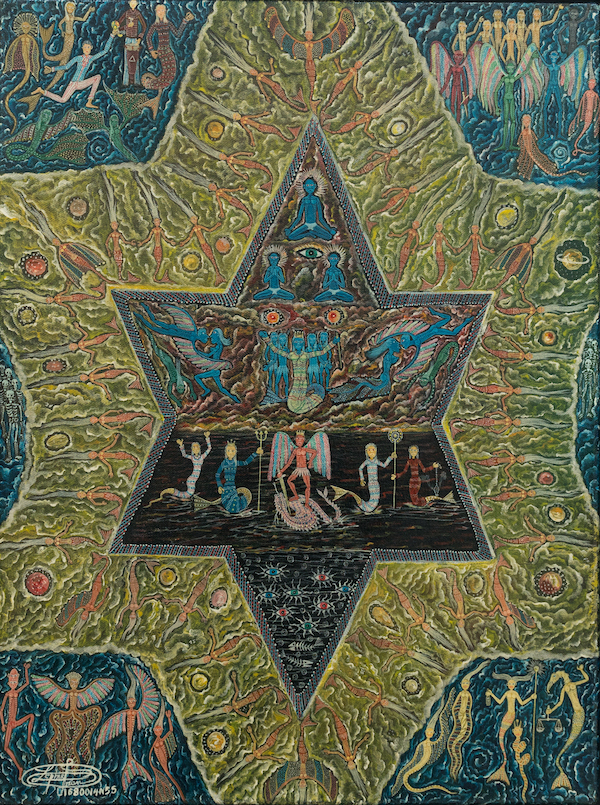Review: In the Eye of the Spiral and WCMA exhibit celebrate Haitian artists
November 2, 2022

“All of us, fractals in the great spiral.” This is how Raynald Leconte, director of In the Eye of the Spiral — a documentary about the Haitian spiritual and artistic movement of Spiralism — explained his work to me when I met him in the lobby of Images Cinema. Leconte is personable and warm, yet surprisingly serious. He is exactly the type of person that you would expect to call in a favor with acclaimed singer-songwriter Annie Lennox, whose narration is featured in the film, for his first-ever feature-length documentary.
On the evening of Oct. 25, Images Cinema offered a one-night screening of In the Eye of the Spiral in conjunction with the Frantz Zépherin: Selected Works exhibition at the Williams College Museum of Art (WCMA), which opened in April. WCMA Mellon Curatorial Fellow Jordan Horton coordinated the screening of the documentary and helped organize the WCMA exhibition.
Produced shortly after the 2010 earthquake and created in response to global narratives of pity for Haiti as a nation, [ITAL] In the Eye of the Spiral chronicles, in the words of Leconte, “the artists who stayed.” It celebrates the nation’s autonomy, providing an alternative story to the tragic one of the earthquake and its aftermath. Annie Lennox provided the narration for the film.
Zépherin, whose work is at WCMA, is one of many such artists featured in the documentary, as he discusses the spiritual logos of his work.
Leconte’s documentary focuses on the Haiitian spiritual and artistic Spiralism movement. Spiralism is a philosophy of coexistence, in which all things — historic events and natural phenomena in particular — exist on a continuum. Practitioners of spiralism utilize this framework to explore various “fractals” — singular events or individuals — as parts of a cohesive whole.
As a newcomer to Spiralism, I was unsure of what to expect, but as the lights in the house came down, the film welcomed me into the philosophy.
In the Eye of the Spiral is split between two functions: detailing the contemporary Haitian art scene and attempting to write a manifesto for Spiralism. The former element is dispersed throughout the film, as individual artists’ interviews are intercut with their works, in conversation with one another and with the nation of Haiti as both muse and setting. These interviews identify Spiralism as an artistic practice, starting with the “eye” and expanding outward.
Spiralist artworks are largely characterized by vibrant colors, beaded and jeweled statues, and surrealist landscapes. Their visual richness is a pleasure to observe, especially when accompanied by ambient music pioneer Brian Eno’s musical stylizations. The footage of the Haitian populace is a particularly striking celebration of the continued survival of the nation following the 2010 earthquake. The chaos Leconte depicts in the streets, in both jubilant crowds and destroyed buildings, lends itself to the larger philosophy of the film. It emphasizes the joys of Haitian reality in the face of tragedy.
That said, In the Eye of the Spiral was Leconte’s first film, and his lack of experience is apparent in how the film treats itself as a manifesto of Spiralism. These sections are a sharp divergence from the on-the-ground footage and take on a pulpit-like tone. This is where Lennox’s narration comes in; she reads spiralist philosophies, accompanied by what looks like stock video footage of spirals in nature and of natural disasters. The dense dialogue and surreal imagery didn’t translate to me as meaningful — just inaccessible. Leconte seems to be asserting the credibility of the movement by associating it with westernized visuals and narrations.
This stylistic choice feels both disingenuous and ineffective at times, given that the power of the movement comes from its origins of resistance and survival in Haiti. These origins are well-illustrated elsewhere in the film and already explain the functions of Spiralism quite effectively. While Lennox’s narration is well-done, it’s jarring. The end result reads as self-conscious, as if Leconte is trying to anticipate and compensate for negative perceptions of the very movement and people that he is highlighting. Nonetheless, the artist-focused sequences keep the film afloat.
The final scene is one of the strongest in the film: One artist spray paints a face in profile onto a wall. A crowd composed of children, mothers, and laughing teens expands around him. The artist’s movements are precise and measured. He is dignified yet joyous, unpretentious yet serious. The anticipatory crowd gathers, jostling one another. The value of his art is buoyed by its communal nature and accessibility to the people. The sparse Images audience, too, reacted almost immediately after the film’s conclusion, falling into a passionate discussion of the film, the art, the nation, and Laconte’s creative process. Though clumsy at times, the overall effectiveness of the documentary is not diminished. At the film’s conclusion, I was still struck by a sense of awe at the art, and the place from which artists drew their inspirations.








